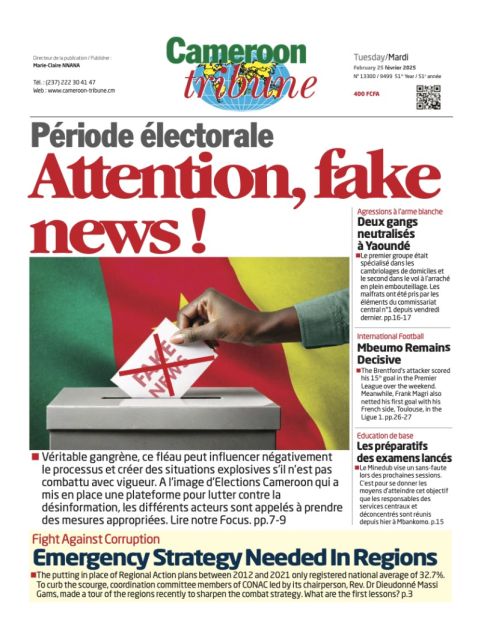Fake News: The Social Media Monster!
- Par Eulalia AMABO
- 25 févr. 2025 14:34
- 0 Likes

Misleading information is mostly created and shared through social and traditional media, though gossips and text messages abound
T he advent of artificial intelligence seems to have an adverse effect on the spread of information. A recent study conducted by the United States indicates that between 50 to 52 per cent of what is generated by AI is true and the rest untrue information. With the upcoming Presidential election in Cameroon, the notion of fake news will certainly linger, for various reasons. Candidates and electoral stakeholders in the electoral process will suffer from the effects of misinformation, disinformation and propaganda. Of course, fake news has the objective of damaging the reputation of a person or an institution, and giving more credence and visibility to the opponent. In today’s world, untrue information is created and shared mostly through the use of the social media especially through Facebook News Feed and websites. Whatsapp and Telegram have made sharing fake news quicker, including the recording of audios which cannot easily be identified. Traditional media, gossips and text messages are other platforms of sharing false information. This misinformation is gradually creeping into the mainstream media, thus undermining the basic rights of freedom of expression and democracy. Several factors have been implicated in the spread of fake news, such as political polarization, post-truth politics, motivated reasoning, confirmation bias, and social media algorithms. Several forms of fake news have been identified, using access to internet to create them. False information is created through satire or parody, that is data generated with no intention to cause harm but has the potential to fool the public on a particular topic or candidate in an election for instance. It is also created through false connection; when headlines, visuals or captions do not support the content being highlighted in major space. Misleading content (using excepts of information to frame an issue or an individual) false context (when genuine content is s...
Cet article complet est réservé aux abonnés
Déjà abonné ? Identifiez-vous >
Accédez en illimité à Cameroon Tribune Digital à partir de 26250 FCFA
Je M'abonne1 minute suffit pour vous abonner à Cameroon Tribune Digital !
- Votre numéro spécial cameroon-tribune en version numérique
- Des encarts
- Des appels d'offres exclusives
- D'avant-première (accès 24h avant la publication)
- Des éditions consultables sur tous supports (smartphone, tablettes, PC)














Commentaires